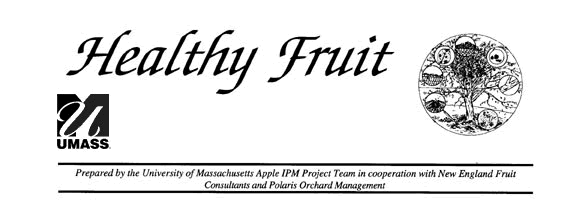
|
|
|---|
McIntosh growth stages for various locations:
Time Critical!
• Monitor leafminer abundance.
Weevil Kneevil
According to the weather model developed in New York, the curculio season in Massachusetts has passed. However, there is some concern, particularly in the later-developing regions of Massachusetts, New Hampshire and Maine, that PC activity may increase yet again.Our observations over the last several days lead us to believe that the warm, sunny weather of late (6/9-6/10) may have inspired the last immigration of the year. This immigration may well be accompanied by substantial late egglaying; late-arriving PC have been known to oviposit in fruit larger than 1 1/2". In orchards where late PC damage is not unusual, we recommend a final border application of Guthion or Imidan, targeting perennnial hotspots.
Mite Hatch, Mite Not
Egg hatch of the first summer generation of red mites began in full force late last week, and nymphs are present in most orchards. Blocks which received a double oil program or miticide treatment remain very clean to date. At this stage, it is too late to use Agrimek or Vendex, or to institute a good summer oil program. What is left are the rescue materials, including Carzol, Kelthane and Pyramite. As has been the case for many years, we do not recommend widespread use of either Carzol or Kelthane, due to harsh effects on predators (Carzol) and rapid development of resistance (both). Pyramite is the best avalable option for use as a summer treatment, but we advise that the mite population situation be assessed during late June before considering a treatment.
Tarnished plant bug, hickory plant bug and oak plant bug are all capable of inflicting high levels of catfacing injury on peaches between shuck fall and 3/4" fruit. However, once the plant bug populations start to tail off, there remains the threat posed by stinkbugs. Times of orchard mowing often hold the most risk; as the understory is mowed, the bulk of the bug population will move up into the canopy for shelter.Given the increased risk of catfacing injury, we recommend that an active, protective insecticide cover be in place for a couple of days prior to mowing. To reiterate the treatment recommended in the May 13 issue of Healthy Fruit, research has shown that any of the OPs are at best 50% effective in preventing catfacing injury. Therefore, we suggest use of a full rate of Guthion or Imidan in conjunction with a one-third labeled rate of a pyrethroid. We feel that because of the tendency of pyrethroids toward high absorption into the bark of the trees (and slow release from the bark) the reduced rate of pyrethroid offers a good compromise. Such a treatment will extend the residual effects of the Guthion or Imidan while limiting the destructive effects against mite predators.
Healthy Fruit is written by Dan Cooley, Ron Prokopy, Starker Wright, Wes Autio, and Karen Hauschild except where other contributors are noted. Edited by Dan Cooley. Publication is funded in part by the UMass Extension Agroecology Program, grower subscriptions, and the University of Massachusetts IPM Program. Healthy Fruit is available on the Web at The Massachusetts Tree Fruit Advisor, (click here). A text version can be e-mailed to you if you contact me, at dcooley@microbio.umass.edu. Please cite this source if reprinting information.